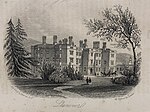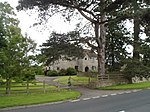St Bartholomew's Church, Llanover
14th-century church buildings in WalesChurch in Wales church buildingsGrade II* listed churches in MonmouthshireHistory of Monmouthshire

The Church of St Bartholomew, Llanover, Monmouthshire is a parish church with its origins in the period following the Norman Conquest. The nave appears the earliest part of the present building, with the chancel dating from the 14th century, the tower from the 16th century and the porch from the 18th century. After a limited Victorian restoration in the middle of the 19th century, the church has been essentially unchanged. It is a Grade II* listed building.
Excerpt from the Wikipedia article St Bartholomew's Church, Llanover (License: CC BY-SA 3.0, Authors, Images).St Bartholomew's Church, Llanover
A40,
Geographical coordinates (GPS) Address External links Nearby Places Show on map
Geographical coordinates (GPS)
| Latitude | Longitude |
|---|---|
| N 51.7793 ° | E -2.99 ° |
Address
Llanover Church
A40
NP7 9AH , Gobion Fawr
Wales, United Kingdom
Open on Google Maps







